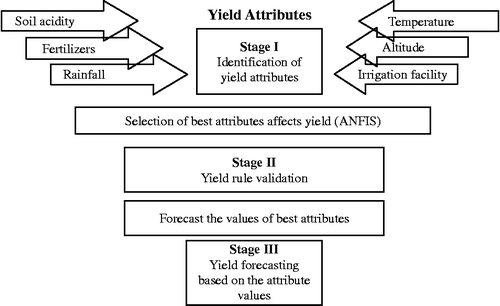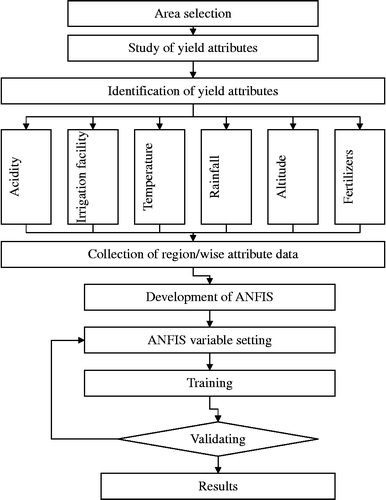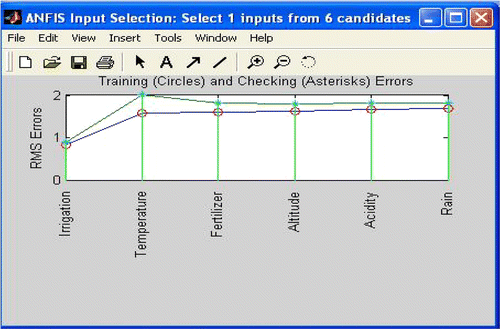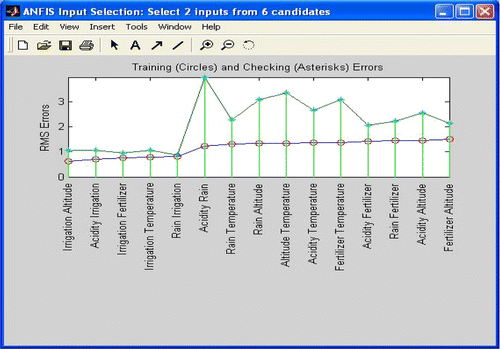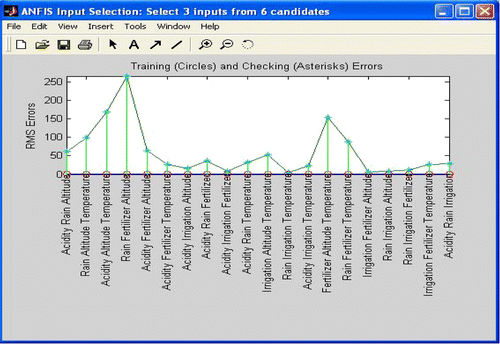Abstract
Jatropha seed yield prediction is one of the most important influencing factors for developing a supply chain modelling of Jatropha seed. The oil from this Jatropha seed is used to blend with diesel to obtain biofuel (Hiromi, Yamamoto, Junichi Fujino, and Kenji Yamaji. 2001. “Evaluation of Bioenergy Potential with a Multi-regional Global-Land-Use-and-Energy Model.” Biomass and Bioenergy 21: 185–203). The Jatropha plant is easy to cultivate and produces high yield if properly maintained. The main focus of this study is to utilize uncultivable wastelands for cultivating Jatropha seeds. As suggested by Liu et al. (Liu, Xiaohong, David B. Grant, Alan C. McKinnon, and Yuanhua Feng. 2010. “An Empirical Examination of the Contribution of Capabilities to the Competitiveness of Logistics Service Providers: A Perspective from China.” International Journal of Physical Distribution & Logistics Management 40 (10): 847–866), the effectiveness of prediction affects the functional characteristics of a supply chain network design. The yield prediction of Jatropha seeds has two important roles which include (i) the identification of external parameters that affects the yield and (ii) the detection of internal attributes that changes the growth characteristics of the Jatropha plant. The development of the fuzzy inference system is characterized by a large number of input variables (Dobrila Petrovic. 2001. International Journal of Production Economics 71: 429–438). A Matlab programming software was used to integrate an adaptive neuro-fuzzy inference system. This approach gave the numerical as well as graphical output that was used to interpret the final result. The root mean square error values were identified for the given inputs which were then compared with the trained input variables to select the best input among the given alternative variables.
1. Introduction
Biodiesel is a promising alternative source of fuel. It can also be used directly in diesel engines, as it ha s a high cetane number and a calorific value that is close to diesel (Senthilkumar, Ramesh, and Nagalingam Citation2003). Kabir et al. (Citation2009) explained that the production of Jatropha for biodiesel has advantages such as employment opportunity, environmental improvements and quality of rural life enhancement. Although searching for land for the cultivation of Jatropha is not necessarily easy, a good crop of Jatropha can be obtained with little effort. Therefore the main focus of this study is emphasized to make use of uncultivable wastelandss (Yamamoto, Fujino, and Yamaji Citation2001) for cultivating jatropha seed. For a given location, it is imperative to identify the yield of Jatropha seeds. The yield prediction of Jatropha seeds is one of the most important factors for developing a supply chain modelling. The effectiveness of prediction affects the functional characteristics of a supply chain network design (Heller Citation1996). The yield prediction of Jatropha seeds has two important roles which include (i) the identification of external parameters that affects the yield and (ii) the detection of internal attributes that changes the growth characteristics of the Jatropha plant. The direct measurement of Jatropha seed yield is difficult, and thus the indirect measurement has become an active subject in the supply chain network model. The seed yield of Jatropha depends on various factors including its species variety used for cultivation. This plant is one of the fast-growing plants and grows to a height of nearly 3–5 m, which can be propagated by seeds and stem cuttings.
Jatropha is one of the most easily cultivable biofuel crops with a high degree of yield. There are various factors that affect the yield of Jatropha seeds, which are discussed below.
2. Supply chain management of Jatropha seed
The supply chain network is sustainable and delivers value from ‘earth to engine’. Crude Jatropha oil produced by the esterification plant is supplied to companies for the production of biodiesel. In an era of globalization characterized by frequent mergers and acquisitions, manufacturers, transportation providers and distributors often experience redundancy in sourcing, capacity and warehousing as well as issues with distribution networks and customer supply. Given these conditions, the need for a framework for a superior supply chain network analysis and validation for Jatropha seeds has posed a new challenge. The determination of the optimal number of locations for storing seeds, crushing plants (esterification), the size of facilities, balance extraction, inventory and transportation trade-offs seize the new opportunities. An advanced analytical tool needs to be modelled and reviewed for the network design of Jatropha seeds and a solid framework for operational supply chain execution.
3. Factors influencing Jatropha yield
The total yield of seed is influenced by many factors, including climatic conditions, usage of fertilizers, soil type, altitude and processing (Trappey et al. Citation2008).
Climatic conditions. This plant grows in any climatic conditions, but it gives a better yield in warm climates. However, the temperature and rainfall patterns affect its growth.
Fertilizer usage. An organic fertilizer improves the yield of Jatropha. Fertilizers such as magnesium, potassium and calcium are added to the soil to increase its quality.
Soil type and property. There are different types of soils available in India. These include alluvial, arid, red, etc.; however, a good result is not obtained in the case of black soil.
Altitude. The altitudinal ranges also affect the yield of Jatropha seeds. Poor results are obtained in the case of hill regions.
Processing. Seed maintenance plays an important role in obtaining a good yield. It should not be exposed to direct sunlight. Thus, some amount of special care is required.
Moreover, many other attributes such as irrigation facility, periodic maintenance and proper agricultural practices including cultivating, harvesting, seeding, planting, regular weeding operations, etc. contribute to the yield of Jatropha seeds. On the basis of the expert's opinion, these six major attributes are considered to be suitable for the study of Jatropha seed yield.
4. Conceptual framework
For the production of Jatropha oil, a warehouse and an esterification plant need to be established in an optimal location. The capacity of the esterification plant and warehouse depends on the production capacity of Jatropha in that region. The production capacity is based on several attributes. The future production capacity has to be predicted based on the existing capacity and future policy. As the future plan is to utilize cultivable wastelands for the production capacity of Jatropha, the total area available in a specified region needs to be identified. After a detailed discussion with farmers and agricultural experts, the six major attributes were considered as design attributes in developing a model. A conceptual method for the attribute selection of Jatropha seed yield is shown in Figure .
5. Predicting Jatropha yield
The initial stage of the supply chain network of Jatropha seed yield is to identify the total yield of Jatropha in any specified region. The crop yield prediction is a non-linear regression problem (Xiao et al. Citation2010). Information about various attributes affecting the yield is used to predict crop yield. Thus, there is a need for attribute data from various farmers and various locations. Therefore, the six input attributes such as irrigation facility, fertilizer usage, rainfall, temperature, acidity and altitude are collected from various farmers and locations to predict the yield of Jatropha. The fuzzy logic and fuzzy inference system (FIS) is an effective technique for the identification and control of complex non-linear systems. The application of a neuro-fuzzy inference system for prediction and identification is a novel approach that overcomes the limitations of a FIS such as the dependency on the expert for the fuzzy rule generation and design of the non-adaptive fuzzy set. The prediction and identification of surface roughness has been the subject of many researches in the manufacturing field. Zargari, Ferasat, and Kharrat (Citation2013) pointed out that computational intelligence models (adaptive neuro-fuzzy inference system, ANFIS) are more accurate, resulting in the lowest error based on actual field data, and are strongly proposed to solve intricate industrial problems instead of empirical correlations and mechanistic models. A notable contribution of neuro-fuzzy and soft computing is the exposition of the ANFIS. The yield prediction of Jatropha is a hard task involving the heterogeneous nature of constraints. Baseri (Citation2011) suggested that the ANFIS model gives satisfying results for the small amount of data. The model can easily be expanded by adding more data.
6. Methodology
An intensive study was carried out to identify the design methodology for this study. The development of the FIS is characterized by a large number of input variables (more than five or six). This task is very difficult especially in knowledge engineering, which involves specifying the real input variables and the related associations, such as the resultant complexity of the rules and database in the system (Petrovic Citation2001). After a detailed discussion with farmers and agricultural experts, the six major attributes were considered as design attributes in developing a model. A conceptual method for the attribute selection of Jatropha seed yield is shown in Figure . The dataset undergoes training to obtain the optimal selection of attributes. The validation is also done through the root mean square error (RMSE) values. Keskin, Taylan, and Terzi (Citation2006) predicted the river flow. The results were compared with the performance of the ANFIS when only a limited number of the observed flows were employed in the training datasets. Murat Ceylan et al. (Citation2010) determined the earthquake load reduction factor of pre-fabricated buildings using the ANFIS. They tested 65 sample frames for which the accuracy rates were found to be 94 and 96%. It gives an alternative way for estimating the load reduction factor.
The initial stage of the supply chain network of Jatropha seed yield involved the identification of yield attributes in a particular region. The attributes such as temperature and rainfall were selected for different regions in Tamilnadu. On the basis of the expert's opinion, the six major attributes (irrigation facility, fertilizer usage, rainfall, temperature, acidity and altitude) were collected for different regions in Tamilnadu. The ANFIS was developed to select the best attributes that influenced the yield.
6.1 Influencing attributes of Jatropha yield
According to Xiao et al. (Citation2010), there were significant trends in climatic variables at different altitudes, and these changes had significant effects on Jatropha seed yield. The different attributes that affect the growth of Jatropha are identified to be temperature, rainfall, irrigation facility, altitude, fertilizer usage, acidity and soil. A combination of all these conditions, along with the consideration of the plant's genetic structure, influences the yield. Although the yield of Jatropha may vary considerably according to such factors, it is possible to estimate the yield of oil.
Xiao et al. (Citation2010) pointed out that an increase in temperature leads to a reduced growth period (from seeding to maturity) and decreases the yield. Moreover, several studies have been conducted to evaluate the effects of climate change on vegetation on large spatial scales, which is helpful for investigating the overall response of vegetation to global warming. Model projections have suggested that increased temperature and decreased soil moisture will reduce global crop yields by 2050. The temperature ranging between 20 and 28°C is suitable for the yield of Jatropha. Jatropha can tolerate high-temperature extremes, but is generally susceptible to frost damage, as pointed out by Heller (Citation1996). In many areas of the world, soil acidity limits agricultural yield. The low content of base cations, especially calcium, and aluminium toxicity affect root growth and the absorption of water and nutrients by plants, usually causing a reduction in crop yields on acid soils (Thornton et al. Citation2008).
Different aspects of climate change, such as higher atmospheric CO2 concentrations, increased temperatures and changes in rainfall patterns, all exert different effects on plant production and crop yields. Jatropha curcas grows well in humid to semi-arid or arid tropical and subtropical environments. It survives well with an average annual rainfall ranging from 200 to 2000 mm, and has the ability to withstand extreme drought and light frost conditions.
The possibility of increasing irrigation facility for Jatropha is a tool that farmers could use to improve yield in terms of quality and quantity. This is at odds with the current situation and predicted trends of water availability for agriculture. In the southern region of India, water availability for productive purposes has generally declined due to the increase in domestic and industrial use. However, climate change forecasts indicate a rise in global temperature (1 to 3.5°C, from the present to the year 2100) and major changes in the distribution of water availability. For some years, there has been a general decrease in rainfall in South Indian regions, which is causing considerable problems in the availability of this resource, especially for land irrigation facility. In addition, the increase in water costs will also have an impact on agriculture due to the increase in energy and distribution rates. The yield of Jatropha seeds varies depending on various factors, including irrigation practice.
The Jatropha plant has an altitude ranging from sea level up to 1800 m. It is not sensitive to the day length. According to Thornton et al. (Citation2008), the yield of Jatropha at high altitudes increases as the temperature increases, but at lower elevations, yield changes also depend on water availability. Elevation has a significant effect on all the yield attributes of J. curcas. The number of branches/tree, the number of fruits/branch and the number of fruits/tree were recorded as maximum at higher elevations (800–1000 m). Similar findings have been reported by Manian and Gopalakrishnan (Citation1995), suggesting that at a higher altitude, there was a dominant utilization of photo-assimilation for growth when compared with the production of oil. The maximum oil content (45.00%) was recorded in non-arable lands at a lower altitudinal range (400–600 m), whereas the oil content was recorded as minimum (22.68%) in arable lands at a higher altitudinal range (800–1000 m). Jatropha has low nutritional requirements; however, the soil pH should not exceed 9 and on very acidic soils, Jatropha might require some amounts of Ca and Mg fertilization. Cattle manure and inorganic fertilizer were tested because these are alternative practices for improving soil fertility and crop yield in livestock-keeping areas. According to Heller (Citation1996), Jatropha is well adapted to marginal soil with a low nutrient content. To support a high biomass production, the crop shows a high demand for nitrogen and phosphorus fertilization. The NPK requirement of this crop is 46:48:24 kg per hectare besides the application of organic manure. Thus, the number of fertilizer uses is considered to be important.
6.2 Selection of major attributes
The use of fuzzy systems (FS) is widespread, mainly in the control systems. Most fuzzy microcontrollers that are currently used in industrial applications are digital implementations. In many applications, the information that describes the expected behaviour of the system is contained in data clusters. Therefore, IF–THEN is elaborated, and if the data clusters are too large, it could imply a tremendous effort. An intensive study was carried out to identify the design methodology for attribute selection. Detailed discussions with farmers and agricultural experts, carried out with respect to yield attributes, led to the identification of six major attributes for developing a model. The FIS, characterized by a large number of input variables, was developed. The common attributes affecting the seed yield of Jatropha in 54 taluks are temperature, rainfall, acidity, irrigation facility, altitude and fertilizers. A decisive methodology for the attribute selection of Jatropha seed yield using the ANFIS is shown in Figure .
6.3 Development of the ANFIS
A quick and straightforward way of input selection for neuro-fuzzy modelling using the ANFIS was developed. The major advantage of using this ANFIS is its smoothness due to the fuzzy control interpolation and its adaptability due to the neural network (NN) back-propagation. The Jatropha yield prediction problem is a non-linear regression problem in which several attributes of Jatropha growth information are used. Sugeno and Kang (Citation1988) proposed the Sugeno fuzzy model in an effort to formalize a systematic approach to generating fuzzy rules from an input dataset. The ANFIS function tunes a FIS with a back-propagation algorithm based on the input data collected. In the yield prediction of Jatropha, which is based on the attributes, increases the complexity of computation necessary for building the model. Thus, it is necessary to develop the input selection method that finds the priority of each attribute inputs and uses them accordingly. The fuzzy modelling and identification toolbox constructs Takagi–Sugeno fuzzy models from data by means of product-space fuzzy clustering.
The objectives of the ANFIS are as follows:
To integrate the best features of FS and the NN:From FS: Representation of prior knowledge into a set of constraints (network topology) to reduce the optimization search space.From NN: Adaptation of back-propagation to a structured network to automate fuzzy control parametric tuning.
ANFIS applied to synthesize the controllers (automated fuzzy control tuning) and models (to explain past data and predict future behaviour).
6.4 Input selection for ANFIS modelling
This section describes the proposed input selection using ANFIS modelling, with application for non-linear regression. The real-world modelling problem normally involves hundreds of potential inputs to the model construction. The input selection method is based on the assumption that the ANFIS model with the smallest RMSE after one epoch of training has a greater potential of achieving a lower RMSE when more epochs of training are given. This assumption is not absolutely true, but it is heuristically reasonable. In this model, out of the six candidate inputs, the three most influential inputs need to be identified using the ANFIS. The ANFIS models can be constructed (each with different combinations of three inputs) and trained with a single pass of the least-squares method. The ANFIS model with the smallest training error is then selected for further training using the hybrid learning rule to tune the membership function. The six major attributes of Jatropha are considered, whose profile information is given below:
Irrigation: multi-valued discrete | |||||
Acidity: continuous | |||||
Temperature: continuous | |||||
Altitude: continuous | |||||
Rainfall: continuous | |||||
Fertilizer: multi-valued discrete | |||||
The attribute to be predicted in terms of the above six attributes is the effect of attributes on the growth of Jatropha seeds. The attribute dataset of Jatropha for 54 taluks is presented in Table . The lists of eight instances are selected at random from the dataset to test the system, which is shown in Table . The next step is to use this dataset and the ANFIS to construct a FIS that could best predict the yield of Jatropha seeds. Before training a FIS, the dataset is divided into the training set and the test set. The training set is used to train (or tune) a fuzzy mode, while the test set is used to determine when the training should be terminated to prevent overfitting. The 54 instances are randomly divided into the training and test sets of equal size (27). Grid partitioning is the most frequently used input partitioning method for the ANFIS. However, for a problem with six inputs, grid partitioning leads to at least 26 = 64 rules, resulting in (6+1) × 64 = 448 linear parameters. It is found that certain inputs having more prediction power can be selected instead of using all the inputs.
Table 1 Attribute dataset of Jatropha in taluk regions.
Table 2 Input attributes from the dataset.
The function ‘exhsrch’ is used to find the input attributes that have better prediction power. Therefore, depending upon the requirement, the number of input attributes can be selected.
6.4.1 Single-input attribute selection
For the single most dominant input as the predictor, ANFIS models can be built. The results are shown in Figure . The training and checking values obtained from Matlab are as follows:
ANFIS model 1: Acidity → trn = 1.6689, chk = 1.8087 | |||||
model 2: Rainfall → trn = 1.6793, chk = 1.8209 | |||||
model 3: Irrigation → trn = 0.8180, chk = 0.8904 | |||||
model 4: Fertilizer → trn = 1.6052, chk = 1.8198 | |||||
model 5: Altitude → trn = 1.6321, chk = 1.8053 | |||||
model 6: Temperature → trn = 1.5886, chk = 2.0224 | |||||
From the above result, ‘irrigation’ was found to be the most single influential attribute selected.
6.4.2 Two-input attribute selection
In the case of the selection of two most relevant inputs as predictors, ANFIS models can be built. A total of 15 fuzzy models of ANFIS training can be built. The results are shown in Figure , with two curves representing the training and test RMSE. These 15 models are reordered according to their training error. Obviously, the best model takes ‘irrigation’ and ‘rainfall’ as the input variables, which is quite reasonable. The model with the least value at the attribute combinations of rainfall, irrigation training dataset trn = 0.8026 and checking dataset chk = 0.8637 is obtained, which is shown in Figure .
This figure demonstrates the result of selecting two inputs. ‘Temp’ and ‘Rainfall’ are selected as the best two input variables, which is quite reasonable. The training and checking errors are distinguished, indicating the outset of overfitting. The function exhsrch selects the three inputs in the next stage.
6.4.3 Three-input attribute selection
Similarly, if there is a need to select the three most significant inputs as predictors, ANFIS models can be built. Thus, a total of 20 fuzzy models of ANFIS training can be built. The results are shown in Figure . In this case, both curves are more or less consistent; this implies that the training and test data were evenly distributed across the original dataset. Once the model with ‘temperature’, ‘rainfall’ and ‘irrigation’ are selected as inputs, performance can be refined via extended ANFIS training. The training error, after decreasing initially, reaches a plateau, oscillates a little bit and then increases. Generally, the test error is used as a true measure of model performance. Therefore, the best model that can be achieved will occur when the test error is minimal. This corresponds to the circle in Figure . Training the data beyond this point decreases the training error, which will degrade the performance of the FIS on the unforeseen inputs. The input selection technique of choosing the three most relevant inputs can result in a non-linear mapping with lower error measures. Similar to 15 ANFIS models of two-input attribute selection, the three-input selection is performed by means of generating 20 ANFIS training models with the training and checking data. The model with the least value at the attribute combinations of rainfall, irrigation and temperature with the training dataset trn = 0.3329 and checking dataset chk = 4.7927 is obtained, which is shown in Figure .
From the above result, ‘temperature’, ‘rainfall’ and ‘irrigation’ were found to be the most influential attributes selected. The result obtained is consolidated for many attributes using Matlab, which is tabulated in Table .
Table 3 Consolidated results from the ANFIS.
This trained FIS is good at interpolation, but not at extrapolation. Without the input selection, it is hard to visualize the data to qualify the scope of its validity before interpreting the ANFIS output correctly. Thus, a quick way of input selection for neuro-fuzzy modelling using the ANFIS was developed. The proposed input selection method can provide an effective means to determine input priorities through heuristic. The success of the method adopted was achieved from the satisfactory error measures that it produced during the testing exercise carried out subsequent to the network training. Therefore, from the above major attributes, the yield of Jatropha can be estimated.
7. Conclusion
The focus of this study was to create an optimal supply chain network model. A model was developed by considering all the uncertainties in the prediction of the seed yield of J. curcas. This model ensures the maximum utilization of agriculture wastelands and maximum profitability to the farmers. The yield of Jatropha is estimated and analysed through the identification of the combination of different attributes for the cultivation of Jatropha seeds. The formulation developed here is proved to be a quite effective cultivation plan that minimizes the risks that are normally encountered due to improper climatic and other resource constraints. In general, the approach to the input attribute selection method is through heuristic, which can provide an effective way to decide the input priorities for ANFIS modelling. It also identifies considerable attributes that have significance in the yield prediction of Jatropha in cultivable wastelands. The success of the method adopted was achieved from the satisfactory error measures that it produced during the testing exercise. From this attribute selection approach, the total yield of any given region can be easily predicted. The yield prediction of Jatropha seeds would provide the support for decision on different stages of the supply chain of Jatropha such as transportation, warehouse location, number of esterification plants, collection centres for seeds and size of plants and the warehouse.
Notes
1. Email: [email protected]
REFERENCES
- Baseri, Hamid. 2011. “Design of Adaptive Neuro-Fuzzy Inference System for Estimation of Grinding Performance.” Materials and Manufacturing Processes26: 757–763.
- Heller, Joachim. 1996. Jatropha Curcas L. Promoting the Conservation and Use of Underutilized and Neglected Crops. Gatersleben/Rome: Institute of Plant Genetics and Crop Plant Research/International Plant Genetic Resources Institute.
- Kabir, E., D.Hussain, A.Haque, and K. H.Kim. 2009. “Prospects for Biodiesel Production from Jatropha Curcas: A Case study of Bangladesh Agricultural University Farm.” International Journal of Green Energy6: 381–391.
- Keskin, Mustafa Erol, DilekTaylan, and OzlemTerzi. 2006. “Adaptive Neural-Based Fuzzy Inference System (ANFIS) Approach for Modeling Hydrological Time Series.” Hydrological Sciences Journal51 (4): 588–598.
- Manian, K., and S.Gopalakrishnan. 1995. “Physiological Basis for Ecological Preference of Eucalyptus Globulus Labill (blue gum) – II Growth and Oil Production.” Indian Forester121 (1–6): 300–305.
- Murat Ceylan, M., H.Arslan, R.Ceylan, M. Y.Kaltakci, and Y.Ozbay. 2010. “A New Application Area of ANN and ANFIS: Determination of Earthquake Load Reduction Factor of Prefabricated Industrial Buildings.” Civil Engineering and Environmental Systems27 (1): 53–69.
- Petrovic, Dobrila. 2001. “Simulation of Supply Chain Behavior and Performance in an Uncertain Environment.” International Journal of Production Economics71: 429–438.
- Senthilkumar, M., A.Ramesh, and B.Nagalingam. 2003. “An Experimental Comparison of Methods to Use Methanol and Jatropha Oil in a Compression Ignition Engine.” Biomass and Bioenergy25: 309–318.
- Sugeno, Michio, and G. T.Kang. 1988. “Structure Identification of Fuzzy Model.” Fuzzy Sets and Systems28: 15–33.
- Thornton, Philip K., Peter G.Jones, AlagarswamyGopal, AndresenJeff, and HerreroMario. 2008. “Adapting to Climate Change: Agricultural System and Household Impacts in East Africa.” Agricultural Systems2: 73–82.
- Trappey, Charles V., HsuFu-Chiang, Amy J. C.Trappey, HouJiang-Liang, and LiuShang-Jyh. 2008. “Technology and Knowledge Document Cluster Analysis for Enterprise R&D Strategic Planning.” International Journal of Technology Management36 (4): 336–353.
- Xiao, Guoju, ZhangQiang, LiYu, WangRunyuan, YaoYubi, ZhaoHong, and BaiHuzhi. 2010. “Impact of Temperature Increase on the Yield of Winter Wheat at Low and High Altitudes in Semiarid Northwestern China.” Agricultural Water Management97: 1360–1364.
- Yamamoto, Hiromi, JunichiFujino, and KenjiYamaji. 2001. “Evaluation of Bioenergy Potential with a Multi-Regional Global-Land-Use-and-Energy Model.” Biomass and Bioenergy21: 185–203.
- Zargari, M. H., A.Ferasat, and R.Kharrat. 2013. “Permeability Prediction Based on Hydraulic Flow Units (HFUs) and Adaptive Neuro-Fuzzy Inference Systems (ANFIS) in an Iranian Southern Oilfield.” Petroleum Science and Technology31: 540–549.

